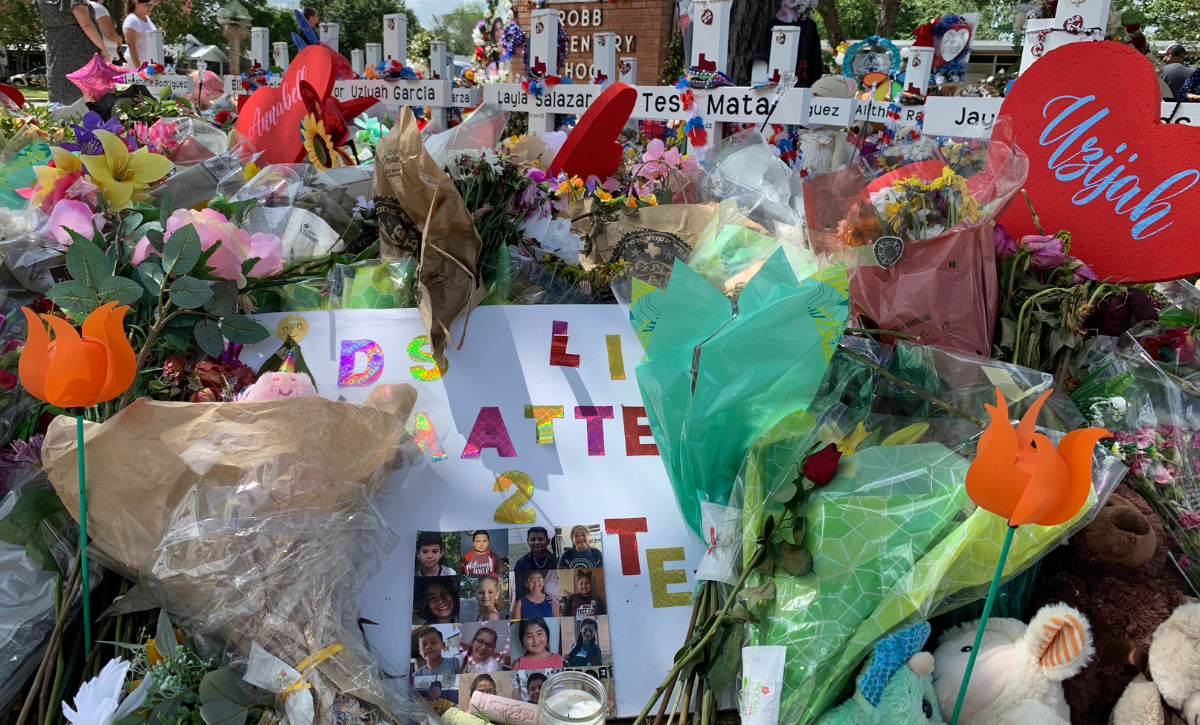Uvalde’s Robb Elementary: Before Tragedy, a Legacy in Advancing Equal Education
‘That school was known to us, the mexicanos, as La Robb.’ Why neighbors say a gunman can’t erase a school’s pivotal role in Texas history

Get stories like this delivered straight to your inbox. Sign up for The 74 Newsletter
The lofty pecan trees outside Robb Elementary School offer some of the only respite to mourners paying respects to the 21 shooting victims in the triple digit heat of West Texas.
But when Josue “George” Garza started teaching at Robb in 1965, the lawn in front of the school was all but bare.
“I saw a barrio school,” Garza said. “The landscaping was almost non-existent.”
Robb will never be a school again and is now known for something far more sinister. But because of people like George Garza, a teacher at the school in the 1960s who advocated for Latino students, Robb stands for something more, outliving what a gunman did there. Garza sparked a movement in the tiny agricultural town in the fight for equal education. Today, Latino students in Uvalde are encouraged to pursue higher education and professional careers, and it all began with a basketball court and some pecan trees at Robb Elementary.
Garza’s six years at the school were all about rallying the Mexican-American community and the students to make improvements the district wouldn’t, like outdoor basketball courts, a track, the pecan trees. As one of few Latino teachers at a school deep in a Latino neighborhood, he wanted the students to see the campus as their own, to take pride in it.
When the principal told Garza maintenance for his pecan trees would be up to him, Garza enlisted the student track team and flag football team to water and stand guard until they were well-established. “We kept them going,” he said.
His son Ronnie grew up in the shade of the trees too, riding his bike around the covered patios, playing on the basketball court even after he moved on to middle and high school.
He doesn’t know who exactly the school was named for—no one seems to—but for Ronnie Garza and his friends, the namesake didn’t matter: It was their school.
“That school was known to us, the mexicanos, as La Robb,” Ronnie Garza said, recalling very different days than those he is living now.
As the county commissioner for the district where Robb Elementary is located, he’s bearing the weight of a grieving community after 19 fourth-graders and their two teachers were killed by a single gunman in their Robb classroom.
While La Robb, which was eventually desegregated to become the 2nd-4th grade campus for the entire district, was in many ways a monument to the struggle for Latino educational equality, the building itself can no longer be a symbol of progress or hope for the traumatized town.
Robb Elementary is now a member of a dreaded club: schools transformed by mass violence.
Some of those schools, like Santa Fe High School and Marjorie Stoneman Douglas in Florida, re-opened. Sandy Hook Elementary in Connecticut, where a gunman killed 20 students and six teachers, was razed and rebuilt.
What happens to the Robb building has yet to be decided, Uvalde school Superintendent Hal Harrell said. But he had one reassurance for grieving Uvaldeans at a special school board meeting on June 3: “We are not going back to Robb school. That will not be a school for our children moving forward.”
Harrell, a lifetime Uvaldean and career educator, was marking a new chapter in Uvalde’s history, a chapter without Robb Elementary, now fully engulfed by the aftermath of the tragedy.
The brick and metal monument sign has all but disappeared among the sea of teddy bears, stuffies, flowers, candles, and posters. Behind it, large cutouts of the victims— forever smiling in photos now familiar from media coverage—are wreathed in flowers. Each tribute seems to make the school’s new status as a memorial more indelible.
Some of the teddy bears are timeless, but it’s the Ty toys with the big, glittery eyes, and career-themed Barbies—the kind of toys the victims likely played with daily—that identify a generation marked by gun violence. Letters in children’s handwriting, small motor skills developing alongside their ability to make sense of tragedy, testify to the gun’s long shadow.
As they do, the memorial has drawn visitors from far and wide. A week after the shooting, most of the people at the school were from out of town, compelled to add to the public lament, to pay respect, to find closure.
Tables have popped up in the shade of Garza’s pecan trees. Some have supplies of carnations and votives for visitors to place. Some tables are manned by volunteers available for comfort or impromptu grief counsel. A muralist works on a tribute across the street.
It’s not the last chapter anyone would have written for the school. But Ronnie said he’s reconsidered his earlier sentiments, when he told NPR’s Adrian Florido that the thought of tearing down the school brought him to tears.
“It’s not about me. It should be about the families and the victims,” Garza said.
The building may be gone, but in many ways, his father’s legacy was less about La Robb, and more about exactly that: giving children the school they deserve.
It wasn’t just the bare lawn and lack of sports facilities George Garza saw when he arrived in 1965. Latino students were treated as second class in nearly every way: They were pushed to enlist in the military instead of going to college. They were given spankings for speaking Spanish. He soon became an advocate for the parents at Robb, who could see the school district’s neglect in the treatment of their children.
“I would say, ‘We can do better, Mr. Principal,’” George Garza said. “I became like a thorn in his side.”
His advocacy eventually got him fired—the principal claimed George wanted to take his job— and that fanned the growing unrest that led to a district-wide walk-out for Mexican-American students in April 1970, one of many youth-led walk-outs during that era of the Chicano movement.
Any student who participated in the walk out was not promoted to the next grade, whether or not they could meet the academic criteria, said Ronnie Garza. The Texas Rangers, notorious for racist violence against Mexicans and Mexican-Americans, patrolled the town. George Garza never got his teaching job back. He did find other ways to serve the cause though—registering voters, teaching at the local junior college, and eventually serving as mayor.
A man of faith determined never to be bitter or resentful, George even hired his old principal to work with him when on the local census.
“It was a tough story, but it had a good ending,” Ronnie Garza said. It wasn’t the story of one heroic man though, both Ronnie and George Garza emphasized. They were part of a determined community.
In 1970, the year of the Uvalde walkouts, mother Genoveva Morales filed a class action lawsuit on behalf of her children against the then-principal of Robb Elementary, claiming Uvalde had failed to desegregate its schools in compliance with the 1964 Civil Rights Act. The Fifth Circuit Court of Appeals agreed, and the lawsuit was batted back and forth unsettled until 2017.
Along the way Robb Elementary became the 2-4 grade campus for the entire district. It would no longer be the elementary zoned for the west side. It was, in that sense, Garza said, desegregated. As the Latino majority in Uvalde has increased, according to census data, Robb has continued to be a predominantly Latino school.
In 2022, 90 percent of Robb’s 535 students were Hispanic, and most of its teachers were as well, including Irma Garcia and Eva Mireles, who were both killed in the massacre. They represented the progress his dad fought for, Ronnie Garza said.
Mireles in particular, extended the ideals of integration to another population, said Audrey Garcia (no relation to Irma Garcia). Her daughter Gabby has Downs Syndrome, and when she entered school in Uvalde in the early 2000s, the district’s policy was to have her in a separate special education classroom.
“Most of the kids who had significant disabilities were segregated,” Mireles said. “That was not an option for me.”
She fought the district to have Gabby included in a regular classroom, but inclusion classrooms require teachers to be able to accommodate student needs and modify lessons to a greater degree than usual, and not every teacher takes up the cause with the same passion. Garcia struggled through each school year, advocating for her daughter and hoping to find that special teacher to become an ally and not an obstacle in her goals for Gabby.
Mireles was that teacher, she said. “She really tried every single method that she could come up with. She was proactive.”
When Garcia thinks about all that her daughter has now accomplished — becoming a high school cheerleader, a competitive CrossFit athlete, and graduated high school with a solid GPA—she said, “I always revert back to Eva as one of the teachers who got her there.”
Gabby is, in many ways, a reminder that the real legacy of La Robb is not in the building, but in those who graduated from it.
Improving schools for Mexican-American students was only part of the goal, Ronnie Garza explained. When Sul Ross State University established an extension campus—Rio Grande College—in partnership with the local junior college, Garza said, Uvalde began to “grow its own” professional class. Kids who didn’t want to work in agriculture could stay in Uvalde.
“Education is a game changer. It levels the playing field,” Garza said.
Whatever becomes of the physical property where Robb Elementary now stands, Ronnie Garza said, isn’t what’s important. What’s important is the legacy of Robb Elementary, and those who fought for it — and the children who deserve an opportunity to learn.
Get stories like these delivered straight to your inbox. Sign up for The 74 Newsletter

;)
